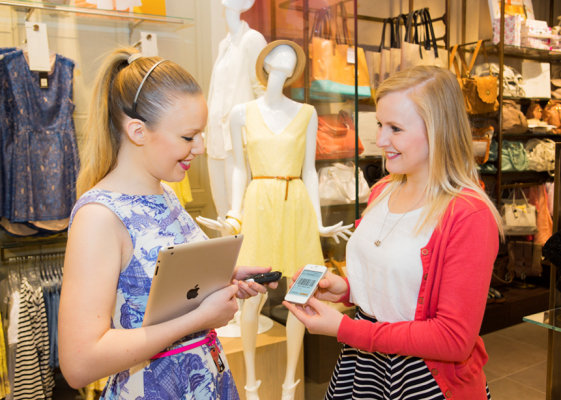Today PayPal opened up a new front in its strategy to expand its role in mobile payments, a business PayPal projects will generate it $7 billion in revenue this year. The eBay-owned payments company today launched a new retail mobile payments app for iOS and Android devices, PayPal InStore, where users can create barcodes that get scanned to deduct payments from users’ PayPal accounts. Available only in the UK, clothing chains Coast, Oasis, Warehouse, and Karen Millen are the first to sign on to the service, and PayPal tells me there are no plans to add NFC to the app any time soon.
PayPal InStore underscores some of the challenges that remain with NFC technology. Yesterday, Gartner presented a picture of a $172-billion mobile payments industry that is still largely based around older technologies like SMS and web-based payments, with newer services like NFC chips playing a very marginal role. And Juniper Research today noted that transactions made on NFC phones in North America and Western Europe will account for less than two percent of all mobile payments this year.
PayPal InStore is one example of how retailers and others can use techonologies available today to offer mobile payments. In this case, a user creates a barcode for a product in the app. He/She then presents their device to get it scanned by the cashier. The amount then gets deducted from a users’ PayPal account.
I asked PayPal whether the door is open for the app to be upgraded to NFC when the chip technology is more ubiquitous — it would certainly make sense, given that it would speed up use of the service. The answer? Not really.
“We think that it will take years for NFC to get any kind of traction in stores, but we are helping retailers roll out mobile payments quickly and cheaply now,” said Rob Skinner, PayPal’s spokesperson in the UK. “We’re not dismissing NFC but our point is that the world may have moved on by the time NFC gets some kind of scale.”
This appears to be the first time that PayPal has launched a barcode-based app. It is not available in the U.S. and Skinner says there are no plans to roll it out elsewhere, either.
“This particular solution is not in the U.S.,” he said, noting that a region-specific service is all part PayPal’s 2012 plan: “It’s a test and learn year for PayPal and our retail partners.”
PayPal last week expanded its mobile payment services in the U.S. by adding 15 more major retailers to the list of those supporting the payments company’s apps in that market. In the UK, the company has a headstart with its branding: as TNW points out its main mobile app broke the 1-million user mark as far back as 2010. Skinner also points out that the high penetration of smartphone users in the UK makes it worthwhile to try out new payment methods here.
PayPal has been looking at a number of different technologies to enable mobile payments. It has trialled NFC, launched a dongle-based service called Here, and looked at ways of using pin codes and credit cards to complete the payments from users’ PayPal accounts — this is the service it has trialled with Best Buy and will likely be the basis of the expansion announced last week. As for PayPal InStore, the Inquirer notes that Windows and BlackBerry versions are also under development.
Meanwhile, Juniper’s NFC projections, in contrast to Gartner’s, are significantly more optimistic about how much NFC will be used, and about how much money will be generated from NFC.
Juniper predicts in its new report that one in four consumers in the U.S. and Western Europe will tap, wave and hover NFC-enabled handsets at points of sale to buy goods by 2017. Juniper’s principal analyst, Windsor Holden, says that works out to $180 billion in mobile NFC transactions by 2017 — just $8 billion more than Gartner believes will be made in mobile payments overall this year. Gartner says that the total transactional value for all kinds of mobile payments will be $617 billion by 2016.
One area where both analysts seem to agree is on the complexity and challenges in making NFC work. Chief among them is that there are a number of parties involved in enabling payments — mobile operators, handset makers, payment providers, retailers and banks — and as Juniper points out a “single point of contact to take responsibility” will be needed to make these services gain credibility with users.
So far, we’ve seen a lot of efforts, including Google Wallet, the Isis consortium, and several commercial projects in Europe (eg, France Telecom working with Visa) — but no clear leader in NFC emerging out of all of that.
